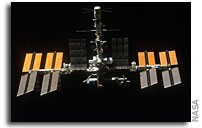NASA Space Station Lead Increment Scientist’s Highlights For the Week of July 6, 2012

(Highlights: June 18 – July 06, 2012) — The Alpha Magnetic Spectrometer – 02 (AMS-02) has collected its 19 billionth cosmic ray event. The AMS-02 uses the unique environment of space to advance knowledge of the universe and lead to the understanding of the universe’s origin by searching for antimatter, dark matter and measuring cosmic rays.
A successful checkout of the vision recognition software for Robonaut 2 was performed. Robonaut also worked with switches and buttons, collecting images of the machine vision cameras for use with future vision recognition tasks. Robonaut not only looks like a human, but it also is designed to work like one. With human-like hands and arms, Robonaut is able to use the same tools station crew members use. In the future, the greatest benefits of humanoid robots in space may be as assistants for astronauts during spacewalks.
Four tests were successfully completed for the Burning And Suppression of Solids (BASS) investigation. BASS examines the burning and extinction characteristics of a wide variety of fuel samples in microgravity. A crew member conducted tests at various air flow speeds and sample widths. For these tests, sample spheres were allowed to burn for several minutes, allowing the flame to spread and cover the entire sphere before turning the flow off to extinguish it. The BASS investigation will guide strategies for extinguishing accidental fires in microgravity. BASS results contribute to the combustion computational models used in the design of fire detection and suppression systems in microgravity and on Earth.
Quiescent test points using 100 percent decane fuel were performed for the Flame Extinguishment Experiment -2 (FLEX-2). FLEX-2 encompasses five distinct investigation classes using pure and bi-component mixed fuels. Quiescent test points investigate diffusive flame behavior, extinction mechanisms, and sooting phenomena in a wide range of combustion chamber atmospheres. Sixteen tests were performed at four different chamber atmospheres all at reduced pressure. The results from FLEX-2 will lead to greater fuel efficiency of liquid-fuel engines and will minimize pollutant emissions. On Earth, FLEX-2 will help in the understanding of combustion generated pollution, and address fire hazards associated with using liquid combustibles.
The first run for Expedition 32 was conducted of the DEvice for the study of Critical LIquids and Crystallization Alice Like Insert (DECLIC-ALI). DECLIC-ALI studies liquids at the verge of boiling. The flow of heat during boiling events is different in microgravity than it is on Earth. Understanding how heat flows in fluids at the verge of boiling will help scientists develop cooling systems for use in microgravity. On Earth, the readily variable properties of near-critical fluids makes them appealing candidates for studying numerous interesting phenomena valid for all fluids, which will ultimately lead to the development of improved solvents for chemistry and the environment.
The Crew Earth Observation (CEO) team has received 124,021 images for review and cataloging. For this investigation, station crew members photograph natural and human-made changes on Earth. These images provide researchers with key data to better understand the planet.
Crew members made successful contact with Cirqiniq Summer Camp in Quebec, Canada, as part of the International Space Station HAM Radio experiment (ISS HAM Radio) By utilizing ham radios, this experiment gets students interested in space exploration by allowing them to talk directly with the crews living and working aboard the space station. To date, crew members have made 45 contacts in 2012 and 735 project events since ISS HAM inception.
Human research investigations continued for various crew members including, Space Headaches, ALTEA Shield, Treadmill Kinematics, Integrated Cardiovascular, and Integrated Immune.
John Love, Lead Increment Scientist Expedition 31/32








